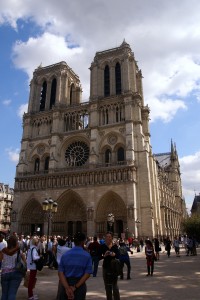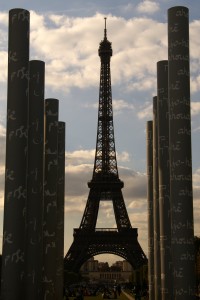30.08.2011 – 30.08.2011 ![]() 31 °C
31 °C
Nice leisurely start today. My plan was to go downtown to the Il De Cite (the first inhabited part of Paris back before JC) and do the main sites of the Cite and if I had time to go to the Musee d’Orsay.
Before going site seeing I stopped downtown on the Rue de Rivoli (main shopping street) to look for a couple of English bookstores. I wanted to buy my brand of guide book for both Paris and Britain (the guide book I have for Paris I’m not super excited about). I was disappointed to discover that neither English bookstore had my brand and I also discovered that I hadn’t brought my other guide book either, so after having morning tea in the Tuileries garden I returned back to the hostel to find my guide book.
 An hour later I set off for the island of Il De Cite. I got off before the Cite and crossed the Seine taking in the site of the Louvre without a million and one tourists (it’s closed today). I went to Notre Dame via the Saint Chapelle church (one of the only remaining parts of Louis IX’s palace). Unfortunately it too was closed today til 4pm, not because it is normally closed on a Tues but because they were filming a documentary in the church today, so I thought I’d make this a stop later in the arvo.
An hour later I set off for the island of Il De Cite. I got off before the Cite and crossed the Seine taking in the site of the Louvre without a million and one tourists (it’s closed today). I went to Notre Dame via the Saint Chapelle church (one of the only remaining parts of Louis IX’s palace). Unfortunately it too was closed today til 4pm, not because it is normally closed on a Tues but because they were filming a documentary in the church today, so I thought I’d make this a stop later in the arvo.
Arrived at Notre Dame to find an absolute horde of tourists waiting to get inside the cathedral (it’s one of the few free things to do in Paris, and also is on everyone’s must do list, so I probably shouldn’t have been surprised). I waited patiently and joined the throng making their way around the cathedral. Notre Dame is famous for its stained glass windows, and I can understand why! The two main rose windows are a real treat as is the main alter piece. Overall though, I wouldn’t say that the interior of Notre Dame is anything to really write home about.. Many of the other cathedrals in Europe are much nicer on the inside than this church. I guess Notre Dame is all about the exterior! I chose not to pay 8E to enter the treasury of Notre Dame so didn’t get to see the relics, maybe they are what make the interior of Notre Dame so special?
I spent a good half an hour wandering around the exterior of Notre Dame trying to get some half decent photos of the famous buttresses and towers. I also had access to the tower via my museum pass so joined the queue waiting to go up. 55min later I was still on the queue and it hadn’t moved in over 20min. Based on the amount of time I had already waited and the line I was still on I decided that no view was worth a wait of >2hrs so left Notre Dame to find the Crypte of Notre Dame!
The Crypte is actually the archaeological digs that have occurred in the square out the front of the church and show the original foundations of the original church and the surrounding houses and streets. (Notre Dame was built on top of an earlier Merovingian cathedral, Saint Etienne). Some of these houses date back to well into Roman times so it was pretty interesting to delve into Paris’ history. In fact, the name Paris comes from the original tribe of people who lived in the area when the Roman’s invaded in 52 BC, the “Parisii”.
From the Crypte de Archaeology I went back to the Palais du Justice (Saint Chapelle is a part of this complex) to the Conciergerie. The Conciergerie is a museum dedicated to the French Revolution and more particularly to the Revolutionary Tribunal. The tribunal was the law court that tried those who were deemed to be ‘counter-revolutionary’ and against the principles of the revolution. The tribunal was held upstairs to the Conciergerie. The Conciergerie itself was actually the prison were the accused were housed whilst waiting for their trial date. The most noted ‘visitors’ to the prison of the Conciergerie were of course both King Louis XVI and Marie Antoinette. The Conciergerie also housed Robespierre at the end of the Reign of Terror. More than 2000 people where guillotined during the revolution and all passed through these corridors. The Conciergerie must have been some place during the revolution, they have mocked up some of the old cells as they would have looked and I would think squalid is probably a pleasant term to describe the cells! Marie Antoinette’s cell was turned into a shrine after the revolution (during the reign of Louis XVIII) but it is clear she had a lot more space than the “average Joe” in the prison.
After viewing the prison it was well after 5pm so I thought I’d give the Saint Chapelle a crack as it should have been re-opened after the filming finished at 4pm. Unfortunately, the film crew must have run over time because the Chapelle was still closed to the public! With limited time left to see any other interior attractions I thought I’d go for a walk along the Seine down to the Eiffel tower for a look.
 The walk itself was hot but really pleasant! The banks of the Seine are dotted with these small second hand book seller/ souvenir sellers so I spent my time amiably wandering from stall to stall. I decided to go to the Eiffel tower via the Palais due Invalides. Invalides was built by Napoleon I as a hospital dedicated to his war- wounded heroes. The palace is pretty specky from the exterior so I would assume that this hospital must have been pretty sweet for the war veterans! (I couldn’t go in as it was past closing time but maybe another day this week?) I finally arrived at the Eiffel tower well after 7pm to discover the line-up was again really ridiculous so I contented myself with taking plenty of shots of the tower but not going up! (Oh well, you can’t do everything right?)
The walk itself was hot but really pleasant! The banks of the Seine are dotted with these small second hand book seller/ souvenir sellers so I spent my time amiably wandering from stall to stall. I decided to go to the Eiffel tower via the Palais due Invalides. Invalides was built by Napoleon I as a hospital dedicated to his war- wounded heroes. The palace is pretty specky from the exterior so I would assume that this hospital must have been pretty sweet for the war veterans! (I couldn’t go in as it was past closing time but maybe another day this week?) I finally arrived at the Eiffel tower well after 7pm to discover the line-up was again really ridiculous so I contented myself with taking plenty of shots of the tower but not going up! (Oh well, you can’t do everything right?)
Headed back to the hostel for some dinner and a well-deserved night’s sleep.
